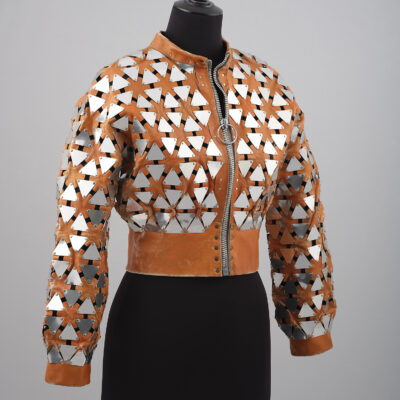
Designers 05.07.2022
15.04.2025
1960s1970scontemporary fashioncountercultureEuropean fashionfashion historyglobal fashionrevivalism
A Revival of Values or Aesthetic?
Beyond the resurgence of polished 1950s aesthetics, contemporary fashion in 2025 is also witnessing the revival of a markedly contrasting style, one deeply rooted in the countercultural movements of the 1960s and early 1970s, where people seeked change due to social and political unrest, protesting against the Vietnam war, POC’s, women’s and LGBTQ+ rights. Some argue that the fashion of this period in history is timeless and never truly disappeared, but with the heated sociopolitical climate of the mid 2020s, this resurgence may signify more than just a stylistic revival. In a period marked by heightened sociopolitical tensions, resistance to far-right extremism, and advocacy for human rights and non-conformity, the parallels between the present day and the countercultural ethos of the 1960s become increasingly apparent.
When analysing the sociopolitical landscape of the 1960s counterculture era alongside today’s world in 2025, a clear parallel emerges. The intersection of political ideology and personal expression continues to shape individual and collective identities, particularly among younger generations who advocate for global peace and social justice. But the question of whether countercultures still exist arises, could this fashion resurgence be purely out of aesthetic purposes? Or do people want to show resistance through their clothing?
Historically, many garments associated with the original counterculture movement were appropriated from diverse cultural traditions. A notable example are Afghan coats, which originated in the Ghazni province of Afghanistan. They were introduced to the Western world by hippies traveling the “Hippie Trail”, a popular route between Europe and Asia, who brought these coats back to the UK, where they were resold and quickly gained popularity. Similarly, Palestinian embroidered dresses became part of the movement after Western women traveling to Palestine incorporated these traditional garments into their wardrobes This cross-cultural exchange highlights both the movement’s embrace of non-Western aesthetics and the ethical complexities surrounding cultural appropriation in fashion.
There’s also a significant group of people rejecting capitalist consumerism in favor of a deeper connection with nature. For these individuals, comfort and practicality are central to their sartorial choices – maxi dresses, flowy tunics, and sandals are just a few examples of counterculture fashion trends resurfacing as a reflection of these values.
While the resurgence of countercultural fashion can be completely performative and not universally rooted in ideological commitment, those who genuinely align with its ideals pursue it ethically by thrifting, handmaking, or sourcing directly from artisans, echoing the approaches of their historical predecessors. The counterculture of the 1960s and 1970s largely rejected the mainstream fashion industry, favoring natural materials over synthetic fabrics and handmade or thrifted garments over mass-produced apparel. With the rise of fast fashion and plastic made textiles the performativity of this type of fashion could be easy to spot, meanwhile internet accessibility, with loads of DIY tutorials and ideas for practical clothing, can be used to pursue true ethical practices in fashion.
Because of this rejection of the fashion industry, it is hard to define who were the fashion designers for the era. But as music was a very important part of this counterculture, it is due to celebrities that somewhat represented this movement that some designers can be given credit where it’s due, as they helped revolutionize fashion during this era. Some musicians had unknown stylists who helped them build an image that correlates to the movement, while others collaborated with designers and brands.
San Francisco-based designer Linda Gravenites was instrumental in crafting Janis Joplin’s bohemian stage presence. As Joplin’s stylist and roommate, Gravenites rejected mass-produced clothing pieces, she preferred pieces like dresses made from repurposed tablecloths.
Jimi Hendrix’s style with fringed jackets, military embellishments, and psychedelic prints was largely the work of designer Michael Braun. Braun’s handmade creations for Hendrix fused historical references with rock-star theatrics. Notably, Braun sourced fabrics like Spanish shawls intended as table coverings, repurposing them into shirts.
Both Anita Pallenberg and Pamela des Barres can be credited to the iconic styles of many rockstars from this era. Actress and style icon Anita Pallenberg was the uncredited stylist behind Keith Richards’ style, mixing Victorian velvets, Native American jewelry, and thrifted fur. Pallenberg’s influence extended beyond the Stones; her layered, multicultural ensembles became a blueprint for rock ’n’ roll’s bohemian elite, while Pamela Des Barres was a pioneer of vintage remixing, dressing rock stars like Jimmy Page and Gram Parsons in Nudie suits, lace hanky dresses, and fringed velvet.
London boutique Mr Fish, run by designer Michael Fish, epitomized the “peacock revolution” in menswear, rejecting postwar austerity with flamboyant kipper ties, ruffled shirts, and most notoriously the “man-dress” worn by David Bowie on The Man Who Sold the World (1970) and Mick Jagger wearing a billowing, bishop-sleeved ivory tunic for the Rolling Stones’ 1969 Hyde Park concert. Jagger’s adoption of Fish’s designs wasn’t merely aesthetic, it was ideological. At a time when men’s fashion was still dominated by suits and narrow ties, Jagger’s embrace of flowing tunics, lace, and velvet (often borrowed from Anita Pallenberg’s wardrobe) mirrored the era’s sexual liberation and blurring of gendered dress codes.
Lesser-known figures like Los Angeles designer Szou, who deconstructed vintage clothing into see-through gowns proved that counterculture fashion was not just anti-establishment but also deeply creative. These artisans operated outside traditional fashion hierarchies, blending thrift, craft, and performance.
The contemporary revival of these stylistic elements operates on multiple levels. On one hand, the accessibility of these garments through second-hand shopping and DIY approaches allows for broad participation. On the other hand, luxury fashion houses have also appropriated these aesthetics, commercializing them within the high fashion market. Brands such as Chloé, with its emphasis on flowing maxi dresses and tunics, Isabel Marant, with its suede bags and fringed detailing, and DSQUARED2, with its fur-trimmed outerwear and cowboy-inspired ensembles, exemplify how countercultural styles have been reinterpreted within contemporary luxury fashion. This duality raises important questions about authenticity, commodification, and the evolving relationship between countercultural movements and the fashion industry.